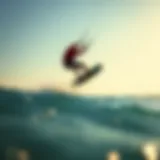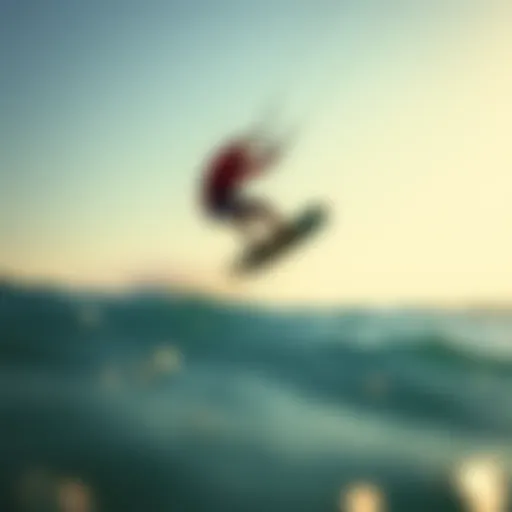The Essential Role of Impact Vests in Kiteboarding Safety
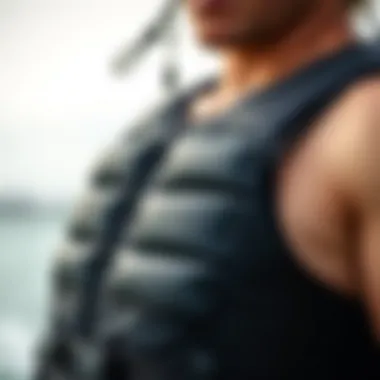
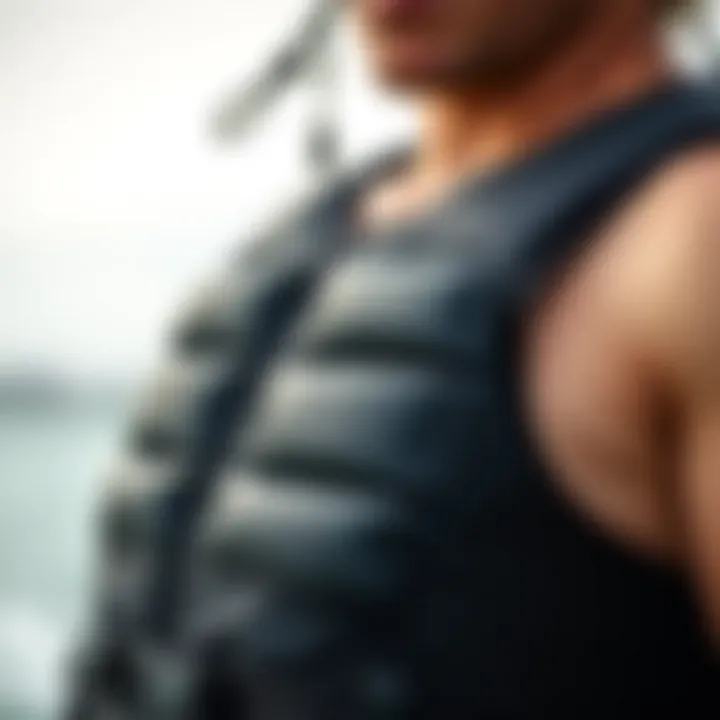
Intro
Kiteboarding, a thrilling water sport that merges the power of the wind with the freedom of the ocean, comes with its fair share of risks. The combination of speed, height, and dynamic movements can lead to accidents, making safety paramount for enthusiasts. This is where impact vests take center stage. Designed to protect the torso and vital organs, these vests have evolved significantly over the years, responding to the needs of various skill levels among kiteboarders.
Rather than just serving as a cushion against hard landings, modern impact vests integrate cutting-edge technology and design principles. They ensure that kiteboarders not only stay safe but also enjoy their rides without feeling restricted. With a focus on performance and comfort, it’s essential for riders to understand what to look for in an impact vest, including options tailored for beginners and advanced riders alike.
This article delves into the world of impact vests for kiteboarding, examining their multifaceted role. We will discuss the techniques that cater to both beginner and advanced kiteboarders, explore product reviews of the latest gear, and provide insight into making smarter choices on the water.
Understanding Impact Vests
Impact vests have become a cornerstone in the world of kiteboarding, offering both safety and performance enhancements for enthusiasts of all levels. They serve a vital purpose, acting as a protective barrier that minimizes the risk of injury from falls, impacts, and collisions while navigating the water. With kiteboarding's unique blend of aerial maneuvers and high-speed thrills, the importance of understanding these vests cannot be overstated.
Definition and Purpose
An impact vest is specifically engineered to absorb shock, providing essential protection for kiteboarders. Unlike standard life jackets, which primarily help with flotation, impact vests focus on reducing the potential for injury due to falls and collisions. They typically feature padded sections that strategically cover the torso and back, where injuries are most likely to occur.
The main purpose of these vests is twofold: to safeguard the rider during unexpected tumbles and to enhance their overall experience on the water. By absorbing the impact and distributing forces more evenly across the body, these vests allow kiteboarders to push their limits without the constant fear of injury. The added confidence can translate into better performance on the water, making it a worthwhile investment.
Evolution of Impact Vests
Historical Context
The journey of impact vests can be traced back to the early days of extreme water sports. Initially, riders relied on basic padding, often fashioned from whatever materials were available. Early models lacked the thoughtful design of modern vests, which often resulted in bulkiness and discomfort. However, this rudimentary protection laid the groundwork for the development of the specialized vests we see today.
Over time, as the sport gained popularity, the demand for effective protective gear led to the emergence of specific brands dedicated to safety in kiteboarding. This historical push has cultivated a culture of prioritizing safety while still offering freedom of movement. Riders recognize that a well-designed vest not only protects but enhances the overall agility in the water, thus generally increasing its acceptance in the kiteboarding community.
Material Advancements
The significant leap in material technology has played a pivotal role in the evolution of impact vests. Early models were constructed from simple foams and fabrics, which provided minimal protection and often resulted in cumbersome vests that limited movement. Fast forward to today, and kiteboarding vests are made from cutting-edge materials designed for durability, flexibility, and comfort.
Modern impact vests often utilize a combination of high-density foam and lightweight fabrics such as neoprene or nylon. These advancements allow for better shock absorption while keeping the vest lightweight, ensuring that kiteboarders can focus on their performance without feeling weighed down.
Moreover, some materials incorporate moisture-wicking technology, which helps keep the body dry while actively participating in the sport, a beneficial feature when taking on the waves. The blending of function and comfort has made these modern impact vests a popular choice among riders, making safety an integral part of the kiteboarding experience.
Importance of Safety in Kiteboarding
Safety in kiteboarding isn't just an option—it's a necessity. As the sport draws people of varying skill levels, from afternoon enthusiasts to seasoned pros, understanding the hazards involved becomes pivotal. The wind carries not only the kite but also the potential for accidents and injuries. It is vital to recognize that a well-informed kiteboarder prioritizes safety, acknowledging that protective gear plays a significant role in minimizing risks.
Common Injuries in Kiteboarding
Types of Injuries
In kiteboarding, injuries can arise from a variety of scenarios—falls, collisions with equipment, or even the power of the wind itself. Common injuries include:
- Concussions: Often a result of hard landings or collisions when the kite is dangerously close to the water.
- Fractures: Particularly in the arms, wrists, and collarbones as riders try to brace themselves during crashes.
- Soft Tissue Injuries: Sprains and strains are frequently reported, especially in the lower body, as kiteboarders maneuver.
These injuries underscore the importance of wearing impact vests that provide cushioning and support. Though no gear can guarantee absolute safety, having proper protection certainly decreases the likelihood of serious harm.
Statistical Analysis
Examining injury statistics from kiteboarding events reveals startling insights. According to multiple studies, a substantial percentage of kiteboarders sustain injuries each year, with estimates suggesting that around 30-40% have experienced an injury severe enough to require medical attention. This data serves as a stark reminder of the sport's inherent dangers and emphasizes the role that safety measures, including impact vests, must play in risk management.
One unique aspect of these statistics is that they often highlight the specific environments where injuries are more likely to occur, like crowded beaches or poor weather conditions. By analyzing this data, kiteboarders can make better decisions regarding when and where to ride, which is essential for enhancing their safety.
The Role of Protective Gear
Impact Vests vs Other Gear
When considering protective gear, impact vests come out on top due to a unique balance of safety and flexibility. Compared to helmets or pads, vests provide full upper body protection while still allowing for a full range of motion, crucial for performance. Unlike other gear that may inhibit movement, impact vests are designed with mobility in mind. They reduce impact forces during falls, which can be a game-changer in preventing severe injuries.
However, there are also downsides. Vests can feel bulky for some users, and not all designs are equally effective. Therefore, it is essential to choose quality products that meet recognized safety standards.
Integrating Safety Equipment
It’s one thing to wear an impact vest; it’s another to think about the entire safety ecosystem. Integrating safety equipment involves the synergy between various pieces of gear—helmets, wrist guards, and impact vests working together. This holistic approach can enhance overall protection significantly. For instance, using a high-quality helmet in conjunction with an impact vest can help prevent concussions, a common injury in kiteboarding.
Another consideration is that integrating safety equipment encourages a culture of responsibility in the community. When more riders adopt comprehensive safety measures, it raises awareness and promotes a proactive attitude towards safety. On the flip side, if safety is ignored, inexperienced riders may attempt dangerous stunts, leading to unwanted injuries—something that could easily be avoided with the right equipment and mindset.
"An ounce of prevention is worth a pound of cure."
This adage rings especially true in kiteboarding, where the right gear can be the difference between a thrilling ride and an unfortunate incident.
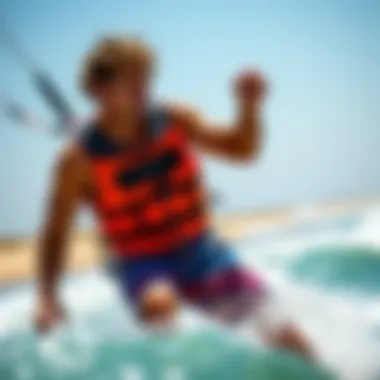
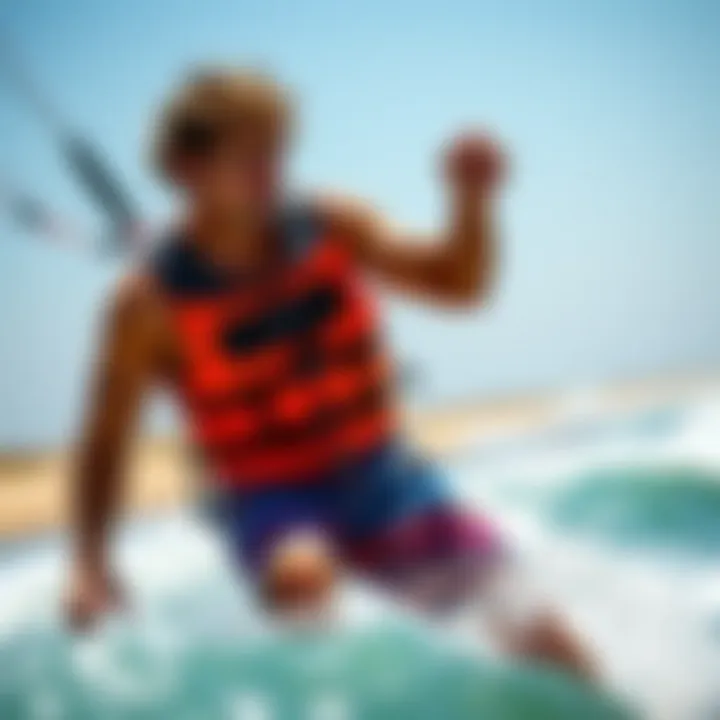
Features of Modern Impact Vests
In recent years, impact vests have become more than just safety gear; they've transformed into essential tools that enhance the kiteboarding experience. The importance of modern impact vests goes beyond mere protection. With advancements in design and materials, these vests offer comfort, flexibility, and functionality tailored for varying skill levels. In this section, we will delve into the most significant innovations that set modern impact vests apart and how they contribute to a safer and more enjoyable kiteboarding experience.
Design Innovations
Ergonomic Fit
The ergonomic fit of today’s impact vests is a game changer in the kiteboarding community. This design aspect focuses on contouring the vest to the natural shape of the body, which not only enhances comfort but also ensures maximum mobility while riding. The contours of the vest hug the body closely, significantly reducing any bulkiness that traditional vests might have had.
A key characteristic of the ergonomic fit is its emphasis on anatomical positioning, allowing for unhindered movement during maneuvers. This fit is particularly beneficial for kiteboarders who need to change their posture frequently, as a snug fit keeps the vest from shifting around, cutting down on distractions. One of the unique features here is the use of multi-panel designs that allow the vest to move with the rider, rather than against them. The advantage is clear: improved performance and ease of use make these vests a popular choice among enthusiastic kiteboarders.
Ventilation Systems
Ventilation systems in modern impact vests address the age-old problem of overheating during long sessions on the water. A well-ventilated vest allows airflow, promoting a more comfortable experience for the wearer. Many new designs incorporate mesh panels that help wick away moisture while allowing air to circulate freely.
The notable characteristic of effective ventilation systems is their ability to balance warmth with breathability. Riders staying cool is essential, especially in warmer climates where overheating can lead to fatigue and reduce performance. The unique feature here is the layering of breathable fabrics, which ensures that while a rider receives protection, the comfort level is never compromised. One downside to consider is that while the ventilation keeps the rider cool, it may not provide the same level of insulation in colder conditions, but thoughtful models exist to mitigate that effect.
Materials Used
High-Density Foam
The use of high-density foam in impact vests elevates their protective capabilities significantly. This material absorbs shock effectively, spreading out the force of an impact to reduce injury risk during falls or collisions. The durability of high-density foam is another key characteristic, ensuring that the vest maintains its protective qualities over multiple sessions.
Adding high-density foam is a smart choice for kiteboarders active in rougher conditions or those experimenting with tricks, as it lends extra confidence in the gear. A unique aspect of high-density foam is its ability to resist water absorption, allowing the vest to remain lightweight even after extended exposure to the ocean. The disadvantage could be seen in terms of flexibility; some riders may find the stiffness a bit constraining, particularly if they prefer a looser fit while riding.
Neoprene Technologies
Modern neoprene technologies have revolutionized the way impact vests function, blending flexibility with resilience. Neoprene is well-known for its water-resistant properties, making it an ideal choice in water sports gear. One standout characteristic is its flexibility, allowing for comfortable movement without sacrificing protection.
The edge of neoprene lies in its insulation capabilities as well, which helps keep kiteboarders warm in cooler waters while resisting abrasions. A key advantage once again emerges: a neoprene vest can be both protective and comfortable. Unique features include newer, eco-friendly formulations of neoprene that maintain the same standards while being gentler on the environment. However, a drawback is that, for some, the thickness might lead to less movement in high-intensity maneuvers, demanding thoughtful selection based on activity level anyway.
As we progress, it’s clear that modern impact vests have evolved significantly, marrying function and form in a way that enhances kiteboarding. The right mix of design innovations and material choices means that today’s vests are a must-have for those looking to maximize safety and performance on the waves.
Different Types of Impact Vests
Kiteboarding is a thrilling sport filled with adrenaline and excitement, but safety always comes first. One of the most important aspects of staying safe on the water is choosing the right impact vest. There are various types of impact vests available, each with its unique features and intended uses. Understanding these differences helps kiteboarders make informed choices tailored to their individual needs and skills, ensuring a more enjoyable experience while minimizing injury risk.
Lightweight Vests
Lightweight impact vests have carved out their niche in the kiteboarding world, primarily praised for their ease of use and comfort. These vests are designed for those who demand flexibility and freedom of movement while still protecting against impacts and minor falls.
Target User Base
The target user base for lightweight vests typically includes beginners and intermediate kiteboarders. These users often look for protective gear that won't hinder their performance or movements. Lightweight vests, by design, tend to be less bulky than their counterparts, allowing riders to maneuver more easily. The low-profile nature makes them a popular choice, especially among first-timers.
One key characteristic of lightweight vests is their ability to provide sufficient protection without feeling cumbersome. This is especially beneficial for those still developing their skills. However, it’s essential to note that while they offer some level of protection, they might not guard against severe impacts as effectively as heavier vests.
Performance Considerations
Performance is a significant consideration when choosing an impact vest. Lightweight vests excel in scenarios where agility is critical. Their design supports quick movements and facilitates optimal airflow, keeping riders cool and comfortable. Some models feature strategically placed padding to protect critical areas without adding excess weight.
Many experienced kiteboarders leverage lightweight vests for freestyle maneuvers and tricks, where every ounce matters. However, while these vests focus on comfort and performance, they may fall short in full protection against high-impact collisions, particularly during aggressive riding or challenging conditions.
Full Coverage Vests
Alternatively, full coverage vests offer an entirely different angle to kiteboarding safety. They are bulkier and are designed for maximum protection, making them the go-to choice for serious riders who prioritize safety over elements like weight.
Best Uses
The best uses for full coverage vests are often seen in extreme conditions or for riders tackling challenging waves and tricks. Advanced kiteboarders often prefer these vests when they face higher risks. Their wider coverage area provides more cushioning and protection against hard landings. The substantial padding absorbs impact better, essential for those who tend to push their limits.
Full coverage vests can also be beneficial in colder conditions, as they offer some insulation, keeping the rider warmer. This can be significant for kiteboarders who spend long hours on the water in less than favorable temperatures.
Pros and Cons
While there are numerous advantages to full coverage vests, like enhanced safety and insulation, they do have their drawbacks. One major downside is the limited mobility they provide compared to lightweight options. This bulk can be restrictive, particularly for riders who depend on quick movements.
Additionally, they may retain more water, which could increase drag and weight over time. Thus, it's crucial to weigh the pros and cons based on individual skill levels and riding styles.
Choosing the right impact vest is not just about safety; it's about how it complements your unique style as a kiteboarder. Whether you lean towards lightweight agility or full coverage protection, the choice shapes your experience on the water.
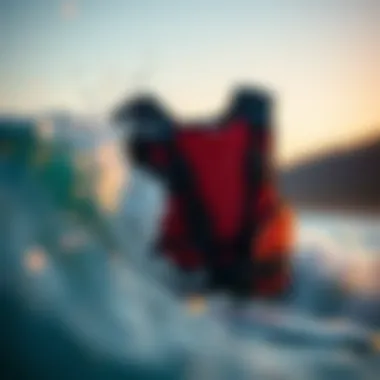
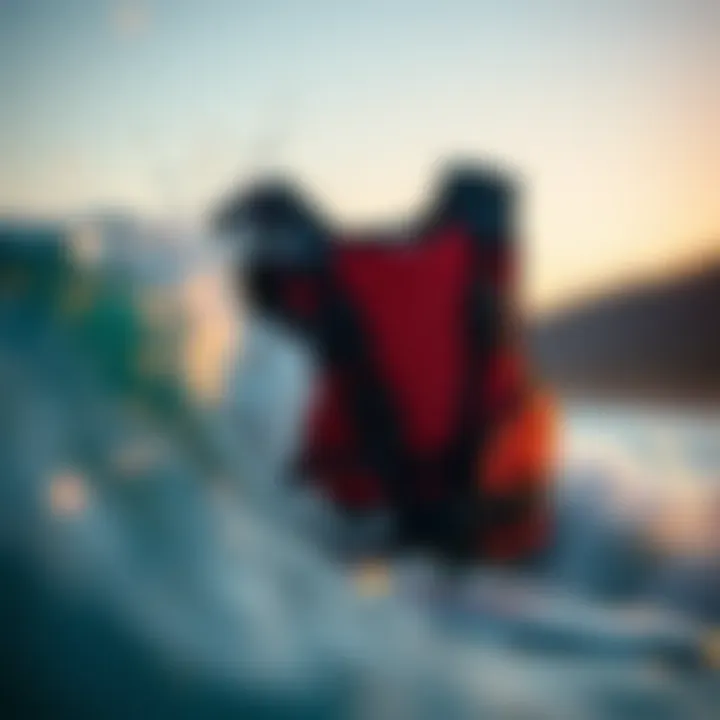
Selecting the Right Impact Vest
Selecting the right impact vest is a crucial aspect of kiteboarding that should not be taken lightly. The impact vest serves as a protective barrier between the rider and the possible hazards of the sport. It’s not merely about comfort or style; it's about safety, performance, and having a vest that's tailored to meet the demands of each unique kiteboarder. Making the right choice can affect not only your performance but also how safe you feel while riding the winds and waves.
Assessing Individual Needs
When it comes to assessing individual needs, one size doesn't fit all in the kiteboarding community. This process includes evaluating your riding style, experience level, and even the conditions you typically encounter on the water.
For instance, beginners might prioritize buoyancy and comfort, while experienced riders may look for less bulk and better maneuverability. Your preference for whether you ride in flat water or choppy conditions can also shape your decision. Considering these factors can streamline the selection process and lead you to a vest that enhances both safety and performance.
Sizing and Fit Considerations
Measurement Guidelines
Measurement guidelines play an absolutely vital role in selecting an impact vest. These guidelines ensure that you get a vest that fits properly, which can significantly affect its effectiveness during use. A snug yet comfortable fit is essential; if a vest is too big, it won't provide adequate protection. Conversely, a vest that's too tight can be restrictive, hindering movements and reducing overall performance.
Common measurements to focus on include chest circumference and torso length. Using a flexible measuring tape, take these measurements while wearing a snug t-shirt to get an accurate size. This attention to detail ensures that your vest is functional without sacrificing comfort, making it a sound choice for any kiteboarder.
Trying Before Buying
Trying before buying is another key aspect when choosing an impact vest. It provides you the chance to experience how the vest feels on your body during movement, ensuring it meets your comfort needs. Many retailers offer in-store trials or allow customers to try vests in controlled environments, which is an excellent opportunity to assess how well the vest allows for movement.
The unique advantage of this method is that it eliminates the guesswork associated with online sizing charts and can prevent potential disappointment in fit or feel after the purchase. Moreover, it gives you the opportunity to explore different models, giving you a better feel for what works best with your own riding style.
Price vs Performance
The price-performance ratio is a crucial element to consider when purchasing an impact vest. A higher price tag often comes with advanced features, but it's important to balance this against your budget and needs.
Budget Options
Budget options can serve as an entry point for novice kiteboarders or those who are just testing the waters. While these vests often come without some of the high-end features, many still offer basic protection and comfort. One standout characteristic of these options is their accessibility.
It's important to remember that even budget-friendly vests can deliver sufficient security if chosen wisely. They can offer a decent level of impact protection for beginners or those who kiteboarding casually, proving to be a pragmatic choice when monetary constraints exist.
Premium Features
Premium features, on the other hand, typically represent the pinnacle of comfort and technology in the realm of impact vests. These might include advanced materials for better impact absorption, build quality that leads to longer-lasting durability, and often customized fitting solutions.
The notable benefit of investing in a premium vest is the enhanced performance and safety it offers. For serious kiteboarders who frequently engage in intense sessions or competitions, this investment can yield long-term advantages, including greater injury prevention and increased comfort during use.
Choosing the right impact vest comes down to understanding your personal requirements, sizing accurately, and making an informed choice between budget constraints and performance needs. Having the right vest not only enhances your safety but also significantly contributes to your overall kiteboarding experience.
Maintenance of Impact Vests
Taking care of your impact vest is crucial to ensuring both its longevity and effectiveness. Since these vests are designed to safeguard against various injuries during kiteboarding, maintaining them takes on a significant role. A well-cared-for vest not only holds its protective capabilities but also enhances your comfort on the water. Here, we delve into how proper maintenance can keep your vest performing at its best, while also expanding its lifespan.
Cleaning and Care Instructions
To keep your impact vest in tip-top shape, regular cleaning is essential. A quick rinse with fresh water after each use is a must, especially after riding in saltwater. Salt can be particularly corrosive and could lead to wear and tear if not addressed. Following the rinse, lay the vest flat to dry in a shaded area, as direct sunlight can damage the material over time.
Remember: Always check the manufacturer’s label for specific cleaning guidelines, as some vests might have unique requirements.
When it comes to deeper cleaning, use a gentle, non-toxic detergent. Avoid fabric softeners, as they can compromise the vest's targeted padding and buoyancy. Never place your vest in a dryer; this can warp its shape and reduce protective features.
Storage Tips
Avoiding Damage
Proper storage is crucial for avoiding damage to your impact vest. After cleaning and drying, store it in a cool, dry place away from direct sunlight. Folding it neatly instead of cramming it into a small space will help maintain the vest’s structured form, preventing creases that might weaken the materials. Consider using a breathable storage bag to keep dust and moisture at bay, which could lead to unwanted mildew.
A key characteristic of effective storage is to avoid anything that could stress the vest's padding, such as heavy objects or tight spaces. This protective measure not only preserves the integrity of the vest but also ensures that it remains ready for action whenever you hit the water.
Extending Lifespan
When you invest in a quality impact vest, extending its lifespan should be a top priority. One significant way to achieve this is by rotating vests, if possible, especially if you kiteboard regularly. By alternating between multiple vests, you allow each one to recover from the wear and tear that comes with repetitive use.
Another effective approach involves periodic inspections for any signs of damage—loose stitching, frayed edges, or hardened sections. Addressing these issues promptly can prevent small damages from escalating into major problems. Maintaining a routine inspection not only extends the vest's lifespan but also augments your overall safety while kiteboarding.
In summary, understanding how to maintain your impact vest involves a combination of proper cleaning, careful storage, and routine inspections. These steps can significantly enhance the durability and functionality of the vest, ultimately keeping you safer and more comfortable out on the water.
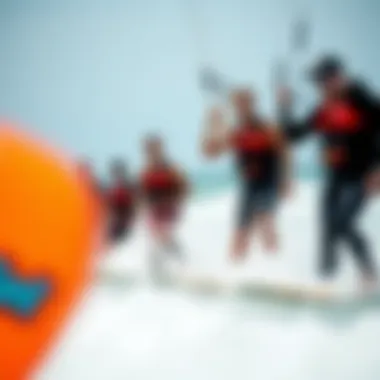
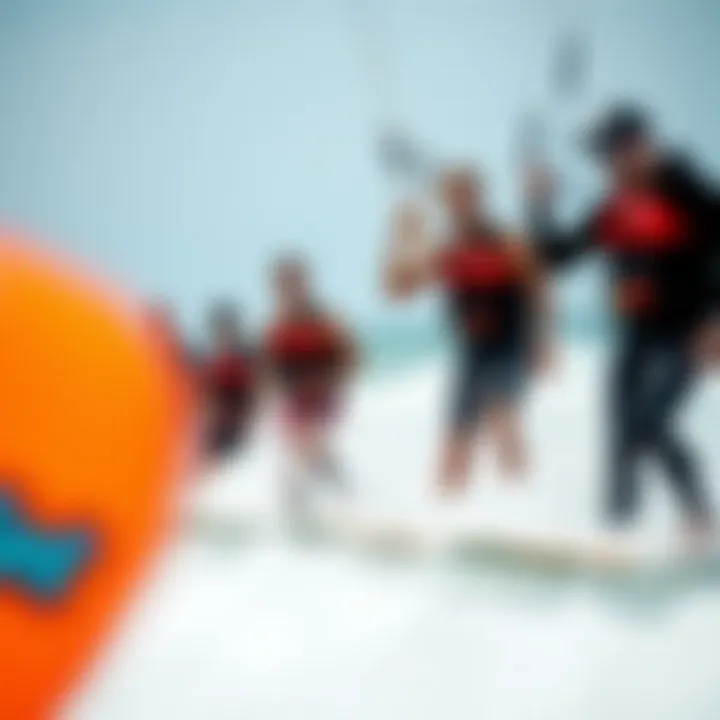
Impact Vests in Kiteboarding Competitions
In the competitive kiteboarding world, the role of impact vests stretches far beyond just safety; it intertwines with performance, regulations, and personal preferences of the athletes. As kiteboarding continues to draw crowds and evolve through technological advancements, understanding the significance of these vests in competitions becomes paramount. This section delves into how impact vests not only safeguard riders but also enhance their game in ways that are crucial during high-stakes events.
Regulations and Standards
Every sport has its regulations, and kiteboarding is no different. The standards for impact vests are put forth by various governing bodies, such as the International Kiteboarding Association (IKA). These guidelines ensure that the gear athletes wear meets a certain level of protection while competing. For instance, vests must pass specific tests to certify their impact resistance. This is vital to foster a fair playing field while at the same time prioritizing the safety of the athletes.
Compliance with these standards means that athletes can trust their gear to provide protection without weighing them down. The impact vests must be tailored not only to withstand heavy hits but also to maintain a lightweight structure that allows for fluid movements. Therefore, competitors need to consider these regulations seriously when selecting their equipment. Knowing that a vest meets these criteria can give riders the additional confidence needed when they tackle waves or attempt daring maneuvers despite the inherent risks.
Performance Enhancements
How Vests Affect Performance
The right impact vest can be a game changer when it comes to performance in competitions. These vests are designed to offer a snug fit, ensuring that they do not flap around while riding, which would create drag and impede performance. With advances in materials, many modern vests now feature high-density foams that protect against impact without compromising on buoyancy. This allows riders to glide with ease while also having that peace of mind.
Furthermore, specific vests designed for competitive use are often streamlined to reduce resistance. Kiteboarders often experience increased agility due to the design innovations in these vests. Being able to shift weight while making turns or jumps is crucial in competitions, and a well-fitted vest that minimizes bulk can significantly enhance a rider's technical abilities. Riders often report that certain vests give them improved responsiveness when executing tricks, adding to their competitive edge.
Competitor Preferences
Athletes in kiteboarding competitions have diverse preferences when it comes to the impact vests they wear. Some gravitate towards heavier, full-coverage vests for the extra protection, especially in high-impact environments. Conversely, others prefer lighter-weight options that allow for greater freedom of movement. This choice often boils down to an individual's confidence level and riding style.
Many competitors have shared that their choice of vest is influenced by the type of conditions they anticipate facing. For example, riders participating in wave events may opt for more robustness to handle sudden impacts with water or equipment. Meanwhile, those focused on freestyle tricks may lean toward a sleeker vest that enables fluid motion but provides adequate impact support.
In essence, the selection of an impact vest becomes a personalized journey for each athlete, factoring in their routine, skill level, and even psychological comfort. Collectively, these personal choices form a mosaic that reflects the unique nature of kiteboarding as a competition-focused sport.
"The vest you choose can become a vital part of your competitive identity, affecting not just safety but performance as well."
In sum, impact vests in kiteboarding competitions serve a dual purpose—they uphold the high safety standards expected in the sport while also enhancing individual performance through thoughtful design and both personal and regulatory preferences.
Future Trends in Impact Vest Technology
As the landscape of kiteboarding continues to evolve, the role of impact vests is also changing dramatically. Their design and functionality are adapting to keep pace with the increasing demands of safety, comfort, and performance. These trends in impact vest technology are critical for both novice and experienced kiteboarders, serving as both enhancements in gear reliability and innovations that can lead to a more enjoyable riding experience.
Emerging Materials and Designs
In the realm of impact vests, the future looks particularly promising with the introduction of new materials and designs. Manufacturers are investing in research to develop not only lighter but also more durable fabrics, allowing for an enhanced protective layer without compromising comfort. One such material making waves is Dyneema, known for its extraordinary strength while being remarkably lightweight. This revolutionary material improves the vest's overall performance and provides kiteboarders with a level of safety that feels akin to a second skin.
Another exciting design trend is the incorporation of segmented padding. By using smaller, independently moveable foam sections, vests can mold better to the body's shape, facilitating freedom of movement. This can be particularly advantageous when performing complex maneuvers. Also, improved ventilation systems are entering the market, allowing sweat to escape while maintaining the vest's integrity, making kiteboarding sessions more comfortable.
Integration with Smart Technology
Integrating smart technology into impact vests can radically change the game. Imagine vests equipped with sensors that provide real-time performance data or monitor vital signs such as heart rate and temperature. This could lead to personalized feedback, helping riders adapt their technique to enhance safety.
Potential Applications
The potential applications of smart technology in impact vests can be vast. For instance, by incorporating GPS tracking and emergency response systems, riders could benefit from added safety measures. The significant characteristic of these applications is their real-time feedback capabilities that could potentially alert users about hazardous water conditions or excessive physical strain. This not only adds a layer of safety but can also help inform better riding practices.
Another unique feature of these applications is their ability to connect with mobile devices. This connectivity means that kiteboarders can analyze their performance stats post-session, refining their skills through targeted feedback. The advantage here is clear: by leveraging technology, riders can stay one step ahead, minimizing risks while maximizing fun.
Market Predictions
Looking ahead, market predictions indicate a healthy growth trajectory for impact vests integrated with smart technology. As kiteboarding gains popularity worldwide, the demand for advanced safety gear will likely escalate.
The key characteristic driving this prediction is the increasing awareness of safety standards in extreme sports. As more riders prioritize their safety, brands focusing on smart technology will likely capture a larger market share.
A unique feature to consider will be the affordability of these high-tech vests. As production technologies improve, the cost could decrease, making smarter vests accessible for the average kiteboarder. This shift has the potential for widespread adoption, making innovative and safe kiteboarding equipment a bestseller.
As we wrap up our exploration of the future trends in impact vest technology, it's evident that advancements in materials, designs, and smart integrations will shape the kiteboarding experience for years to come. Embracing these changes is not just about improving safety; it's about redefining the essence of kiteboarding itself. These innovations promise a future where feedback is instantaneous, safety is uncompromised, and every ride is a step toward mastering the waves.
Closure
The conclusion of this article serves as a critical summation of the evolving role impact vests have in kiteboarding, which embodies not just a layer of protection for riders but a fundamental element that enhances overall safety and performance. Throughout our exploration, we've highlighted how these vests adapt to the unique demands of kiteboarding, addressing both innovation in design and shifts in user expectations.
Recap of Key Points
To put it all in perspective, let’s recap the essential insights drawn from our discussions:
- Definition and Function: Impact vests are essential for reducing injuries during kiteboarding, acting as a shock absorber while providing buoyancy.
- Safety Requirements: The importance of safety gear has never been greater as the sport continues to grow; becoming aware of common injuries and prevention strategies can keep enthusiasts riding longer and safer.
- Material and Design Evolution: Modern impact vests have progressed substantially, integrating new materials like high-density foam and neoprene, resulting in better comfort, flexibility, and performance.
- Personalization: Choosing the right vest hinges on understanding personal needs, sizing accurately, and finding a balance between budget constraints and desired features.
- Future Trends: Our examination of future trends indicates a likely integration of smart technology and continued material innovations, suggesting that the role of impact vests is only set to expand further.
"Safety isn't just a layer you put on; it's the foundation upon which every great ride is built."
Final Thoughts on Impact Vests
As we conclude, it is clear that impact vests are no longer just an accessory but a vital part of kiteboarding culture. Whether one is a novice learning the ropes or an expert tearing up the waves, the right vest can make a significant difference. Investing in quality protective gear is not just about following trends; it’s about ensuring your safety and well-being while enjoying the exhilarating experience kiteboarding offers. With ongoing advancements in technology and material science, riders can look forward to even more effective and comfortable options in the years ahead.
In summary, choosing the right impact vest is not solely about personal preference; it reflects a commitment to the sport and the safety culture it fosters. Enthusiasts should prioritize both safety and performance by remaining informed and careful in their selections, as this could either safeguard against injury or allow for unhindered, thrilling rides on the water.














